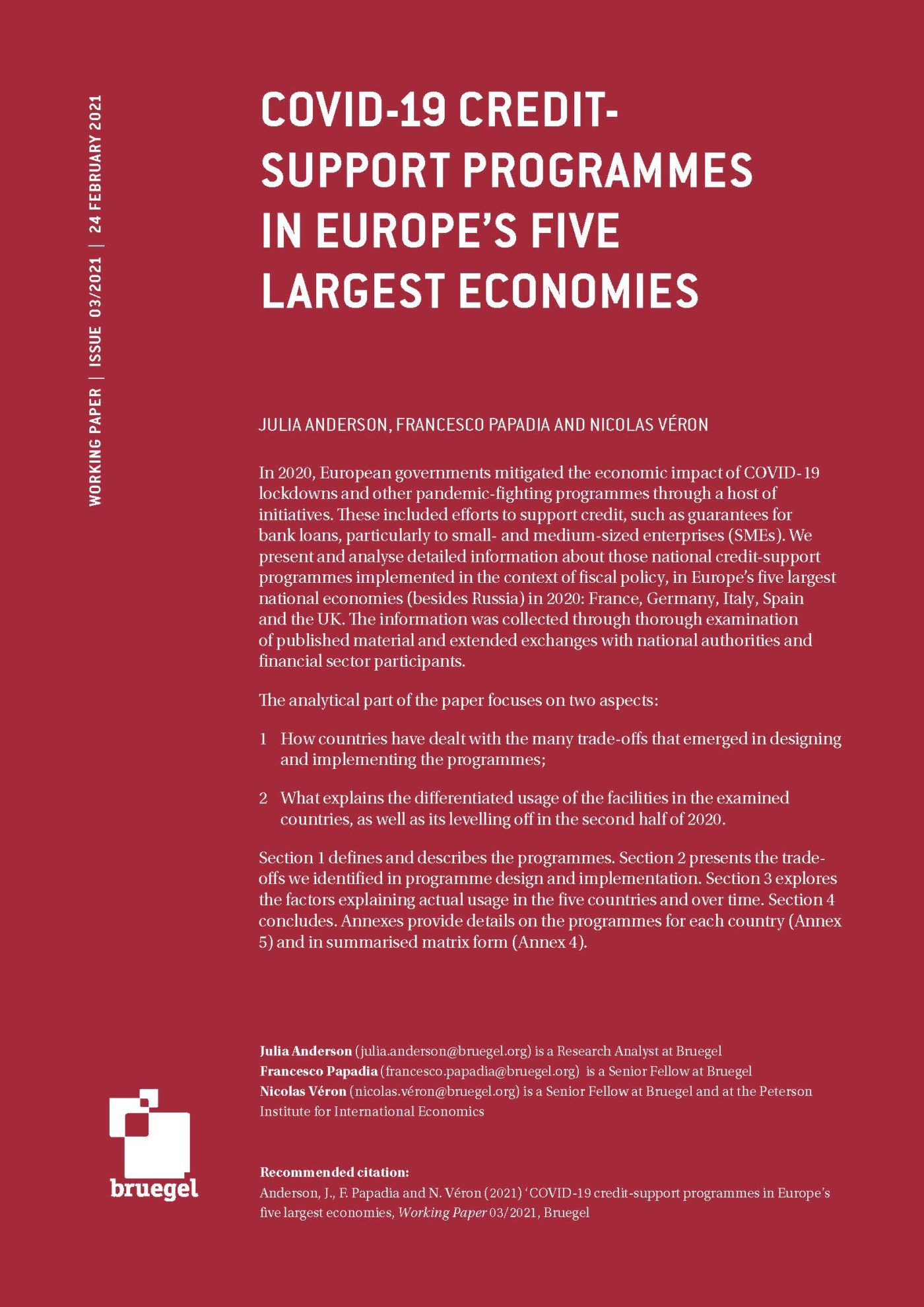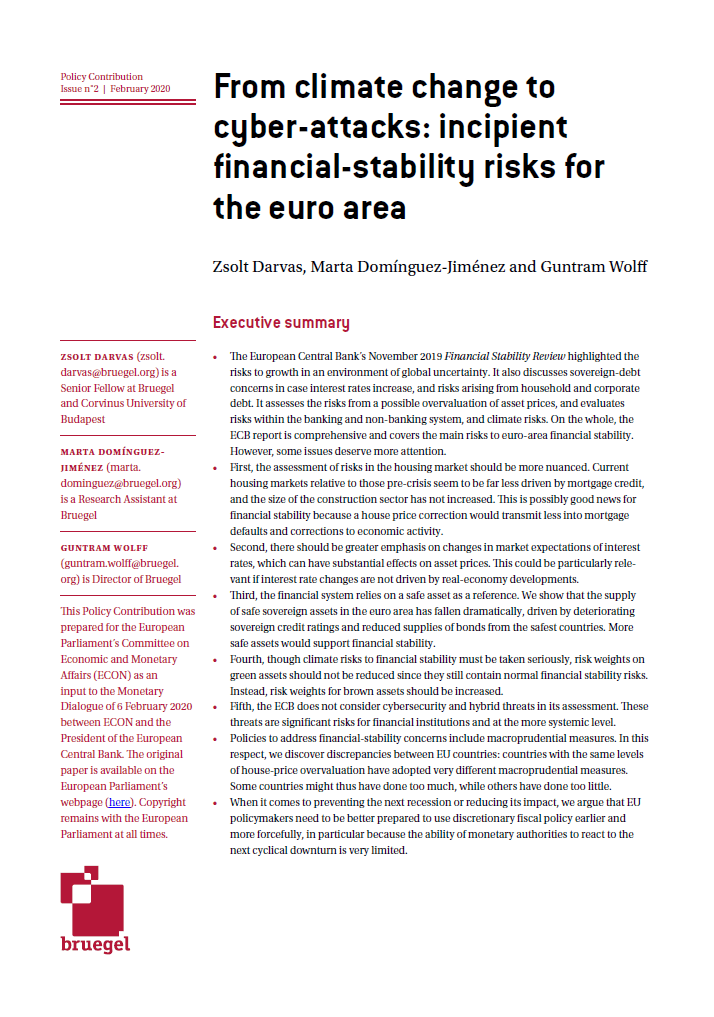Blog Post
The consequences of Italy’s increasing dependence on domestic debt-holders
Bruegel’s updated data set of sovereign bond holdings illustrates how a rising share of Italian debt is held by domestic investors – a development with particularly significant implications, in the context of the Italian government’s disagreement with the European Commission over spending plans outlined in its draft budget.
The data underlying this blog post can be found in the sovereign bond holdings database.
Italian debt is overwhelmingly and increasingly held by resident banks and investors, as shown by the updated figures in our database on sovereign bonds holdings. In this blog post, I discuss possible implications.
The data
Our recently updated database on sovereign bonds holdings shows that Italy maintains some peculiarities in its debt ownership structure. The substantial increase in the proportion of Italian bonds held by the Bank of Italy since 2015 (from 5.8% to 19.3% of total outstanding debt) is an operational consequence of the quantitative easing launched by the European Central Bank, and is common across euro-zone countries. Beside this monetary policy-driven change, however, the portion of remaining bonds held by residents (banks and other investors combined) relative to non-residents has kept increasing since the last observation.
This is all the more interesting given that Italy already had the highest proportion of debt held by residents and the lowest proportion of foreign holders among the most important euro-zone countries (all European countries in our database, namely Finland, France, Germany, Greece, Spain, Portugal and the Netherlands – see Figure 1 for a comparison of the four largest euro-zone economies).
Significantly, the relatively lower share of foreign holders has not been a constant feature: around 2005, sovereign bonds of France, Germany, Italy and Spain were each held by foreigners at a very similar level (in the neighbourhood of 50%). Since then, foreigners have owned an increasingly small share of Italian debt, in particular after the 2011-12 crisis, falling below 35% of the total outstanding debt (they still owned half of it at the end of 2009).
Creditors’ locations matter – a review of the literature
According to Jalles (2018) and Afonso and Silva (2015), the share of sovereign debt held by non-residents increases due to several factors, such as (i) improved fiscal positions, (ii) a strong business cycle position, (iii) systemic stress and financial volatility, and (iv) a higher share of cross-border holdings of sovereign bonds by foreign monetary and financial institutions (MFI).
None of these variables point to an inversion in the trend of Italian debt ownership, given (i) the planned increase of the deficit (in terms of GDP) in the Italian draft budget, (ii) the generalised economic slowdown that characterised the third quarter of 2018 in the euro zone (which translated into downright stagnation in Italy, which registered 0% quarter-on-quarter growth for the first time after 14 quarters of positive, if dismal, growth) (iii) the Italy-specific, and not systemic, stress and financial volatility observed up to now and (iv) foreign banks’ exposure to Italian debt amounting today to less than half the level it reached in 2008 (see the revealing graph by Torsten Slok, international chief economist at Deutsche Bank).
But does the location of a debt owner matter, after all? In general terms, the geographical composition of a sovereign’s creditors matters because of the relationship between these creditors and a government’s (i) borrowing costs, (ii) refinancing risks and (iii) financial stability altogether, through the establishment or reinforcement of the linkage between the sovereign and resident banks (Arslanalp and Tsuda 2012). First, a larger base of investors is associated with lower yields (Andritzky 2012, Arslanalp and Poghosyan 2014). As such, other things being equal, the observed withdrawal of foreign investors from the Italian bond market should be counter-balanced by an increase in domestic investors’ holdings, in order for yields not to increase further. Second, foreign investors are a less stable source of demand for sovereign bonds (Arslanalp and Tsuda 2012). In this respect, Italy’s public finances might prove more resilient than the size of its debt and political developments would suggest – also given the more-than seven-year average maturity of its outstanding bonds (higher than the German and American maturity, for instance). Finally, an increase in the interdependence between domestic banks’ balance sheets and the sovereign’s public finances generates risks for domestic financial stability – with likely large repercussions for the rest of the euro zone in the case of an economy as big as Italy’s.
In the context of the Italian draft budget and the face-off with the Commission, the creditors’ location matters even more. The draft budgetary plan 2019, in fact, includes estimates of the trend growth rate and of the fiscal multiplier associated with the planned increase in deficit, considered excessively optimistic by most observers. The ownership structure of Italian debt might impact both, in different ways.
On the one hand, the increase in the yield of Italian bonds constrains the margins of manoeuvre for fiscal expansion. In fact, the higher the share of (additional) public spending devoted to (increased) interest payment, the lower the fiscal space available for more productive and growth-enhancing expenditure (even though the proposed budget plan does not stand out for its focus on investment, set to increase by a limited 0.2% next year). However, given that residents own roughly two-thirds of the outstanding debt, this should represent less of a drag on growth and more of a mere, mostly internal, expected transfer of income – a point raised by Olivier Blanchard and Jeromin Zettelmeyer too.
On the other hand, research seems to suggest that fiscal multipliers are relatively lower when residents own a higher share of public debt (see Priftis and Zimic 2017 and Broner et al. 2018). The underlying theoretical intuition is that there is a greater tendency towards a crowding-out of the domestic private sector when a relatively higher portion of public debt is in residents’ hands, thereby hampering domestic consumption- or domestic investment-driven expansion. This hypothesis relies on the assumption that the presence of financial frictions might limit private residents from having full access to external financing.
This is not good news for the Italian government, as divergent perceptions of the size of the multiplier lie at the core of the dispute with Brussels, and given that the Italian Finance Minister Giovanni Tria, in his reply to the Commission after the latter’s budget’s dismissal, pledged that “should the debt-to-GDP and the deficit-to-GDP ratios deviate from the planned paths, the Government commits to adopting the necessary measures in order to fulfil those targets”. A lower-than-forecasted multiplier would thus increase the likelihood of higher-than-expected debt and deficit figures, and therefore of a tightening of fiscal policy (which shows, en passant, a surprisingly pro-cyclical stance from the Italian side). Such an outcome is even more likely since the long-run multiplier of public investments in Italy, as shown by Alessio Terzi, is among the lowest in Europe.
“An Italian solution to an Italian problem”?
What could happen then, if the government indeed had to revise its estimates downward and provide a rebalancing of its fiscal position (either through increased revenues or lower expenditure)?
Several signals point to the usual suspects: Italian residents, and their still substantial private wealth. On this, there is perhaps surprising agreement between the Italian ruling parties and some German views. Matteo Salvini, deputy prime minister and minister of the interior, has already suggested that tax cuts might be granted to Italians investing in domestic bonds.
Some form of so-called financial repression, i.e. a more or less gentle diversion of private funds towards public debt, is therefore on the table, as suggested by the Bundesbank economist Karsten Wendorff and explicitly assumed by Moody’s. The former advocates a national fund, financed through “solidarity bonds” that Italian households would be forced to purchase according to a fixed proportion of their net wealth (say, 20% in order to halve total government debt). The latter similarly motivates its stable outlook despite the Italian debt rating downgrade: “Italian households have high wealth levels, an important buffer against future shocks and also a potentially substantial source of funding for the government”.
Such funding might alternatively occur through a substantial one-off property tax, the so-called patrimoniale. This nation-centered approach is in sharp opposition to Banking Union and capital markets union, which aim to spread the holding of sovereign and credit risk across the entire euro area and move away from national concentration of sovereign debt holdings.
The stand-off between Rome and Brussels, and the evolution of market sentiments on the government’s budgetary plans, will have a crucial impact on the ability of Italy to avoid a new recession. In one way or another, however, the role of Italian resident investors in determining the fortunes of Italian debt does not seem set to diminish any time soon.
Republishing and referencing
Bruegel considers itself a public good and takes no institutional standpoint. Anyone is free to republish and/or quote this post without prior consent. Please provide a full reference, clearly stating Bruegel and the relevant author as the source, and include a prominent hyperlink to the original post.








